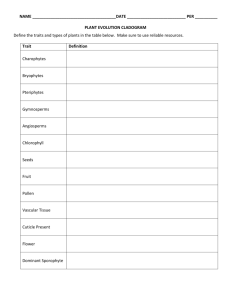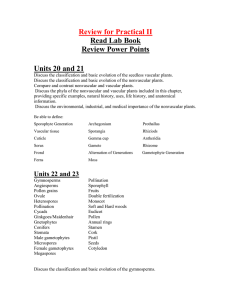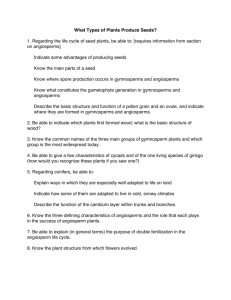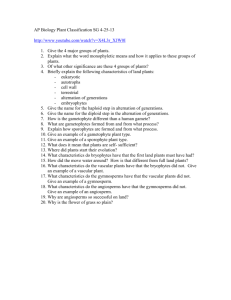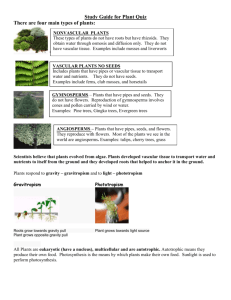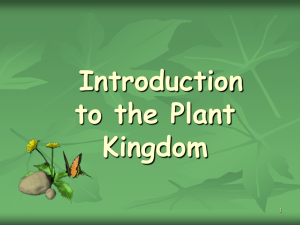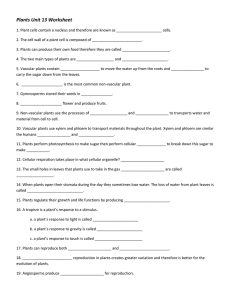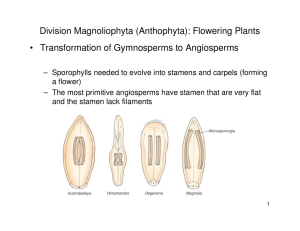Name:____Key_______ Plants and Animals Test Review Vascular
advertisement
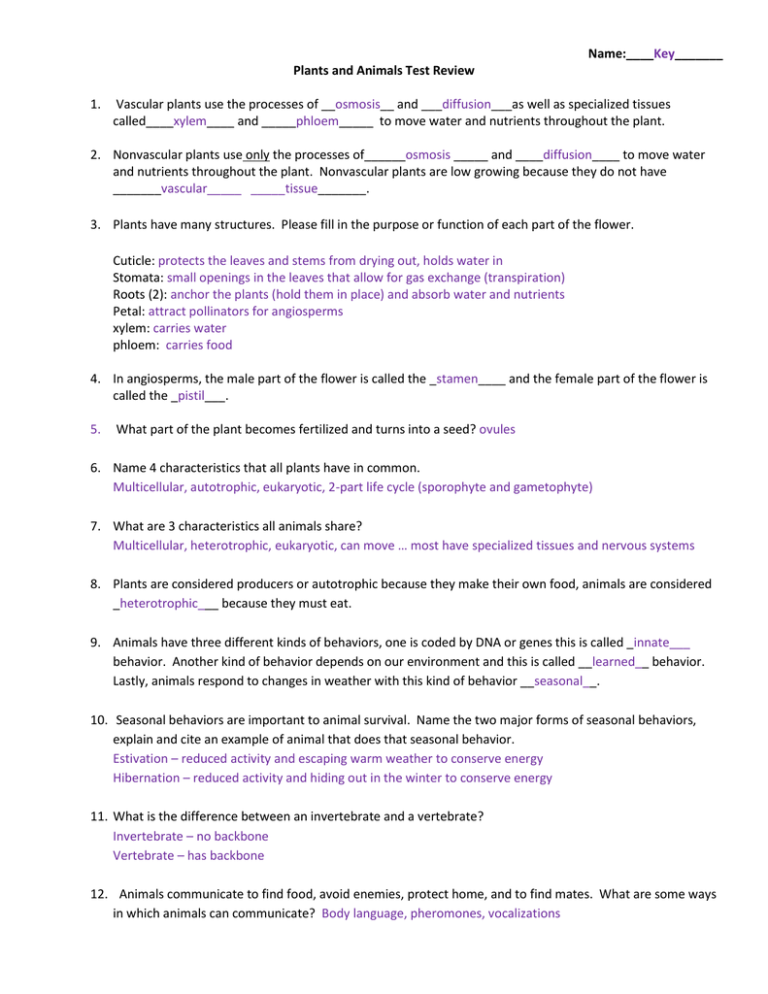
Name:____Key_______ Plants and Animals Test Review 1. Vascular plants use the processes of __osmosis__ and ___diffusion___as well as specialized tissues called____xylem____ and _____phloem_____ to move water and nutrients throughout the plant. 2. Nonvascular plants use only the processes of______osmosis _____ and ____diffusion____ to move water and nutrients throughout the plant. Nonvascular plants are low growing because they do not have _______vascular_____ _____tissue_______. 3. Plants have many structures. Please fill in the purpose or function of each part of the flower. Cuticle: protects the leaves and stems from drying out, holds water in Stomata: small openings in the leaves that allow for gas exchange (transpiration) Roots (2): anchor the plants (hold them in place) and absorb water and nutrients Petal: attract pollinators for angiosperms xylem: carries water phloem: carries food 4. In angiosperms, the male part of the flower is called the _stamen____ and the female part of the flower is called the _pistil___. 5. What part of the plant becomes fertilized and turns into a seed? ovules 6. Name 4 characteristics that all plants have in common. Multicellular, autotrophic, eukaryotic, 2-part life cycle (sporophyte and gametophyte) 7. What are 3 characteristics all animals share? Multicellular, heterotrophic, eukaryotic, can move … most have specialized tissues and nervous systems 8. Plants are considered producers or autotrophic because they make their own food, animals are considered _heterotrophic___ because they must eat. 9. Animals have three different kinds of behaviors, one is coded by DNA or genes this is called _innate___ behavior. Another kind of behavior depends on our environment and this is called __learned__ behavior. Lastly, animals respond to changes in weather with this kind of behavior __seasonal__. 10. Seasonal behaviors are important to animal survival. Name the two major forms of seasonal behaviors, explain and cite an example of animal that does that seasonal behavior. Estivation – reduced activity and escaping warm weather to conserve energy Hibernation – reduced activity and hiding out in the winter to conserve energy 11. What is the difference between an invertebrate and a vertebrate? Invertebrate – no backbone Vertebrate – has backbone 12. Animals communicate to find food, avoid enemies, protect home, and to find mates. What are some ways in which animals can communicate? Body language, pheromones, vocalizations 13. ( Cells - > )Tissues -> _organs__ -> Organ systems-> ___organism___. (Fill in the blanks) 14. Where are mollusks found? On land and in water … generally in moist environments 15. What are the distinguishing characteristics of cnidarians? Also give an example of a cnidarian. Stinging cells (nematocysts), radial symmetry, nerve net, medusa and polyp body forms 16. What are the distinguishing characteristics of annelids? Also give an example of an annelid. Segmented bodies 17. What are the distinguishing characteristics of mollusks? Also give an example of a mollusk. Mollusks have bilateral symmetry, a muscular foot, visceral mass (soft body), mantle (hard shell or beak) Examples – clam, snail, octopus, squid 18. How are chordates different from any other animal phylum? Central nerve cord and most have backbones 19. What are the distinguishing characteristics of echinoderms? Also give an example of an echinoderm. Spiny skin Examples – sea urchin, sea cucumber, sea star 20. List at least two reasons why animals need to communicate with one another? To find food, to find mates, to avoid predators 21. How is pollination different between gymnosperms and angiosperms? Gymnosperms rely on wind and water to transport pollen between male and female cones Angiosperms rely on pollinators to carry pollen from the anther (of the stamen) or one flower to the stigma (of the pistil) of another flower. 22. Explain pheromones and give an example of how animals use them? Pheromones are chemical signals (scents) that animals use to communicate. For examples, dogs pee on trees to mark their territory. 23. How does an endoskeleton differ from an exoskeleton? Endoskeleton – internal skeleton Exoskeleton – external skeleton 24. How does radial symmetry differ from bilateral symmetry? Radial - A body plan in which the parts of the body are arranged in a circle around the central point Bilateral - A body plan in which two halves of an organism’s body are mirror images of each other 25. Draw a cladogram to show the evolution of algae to plants: This cladogram shows the evolutionary relationships between PLANT TYPES, with characteristics common to all plants at the bottom. Nonvascular Vascular, seedless Gymnosperms Angiosperms flowers seeds vascular tissue cuticles, cell walls, multicellular, eukaryotic, autotrophic, do not move, asexual and sexual reproduction
